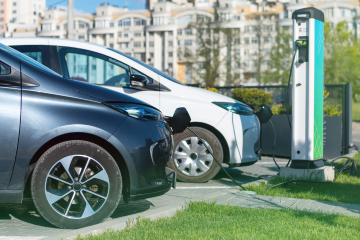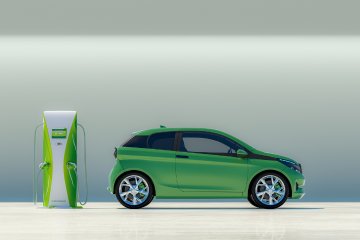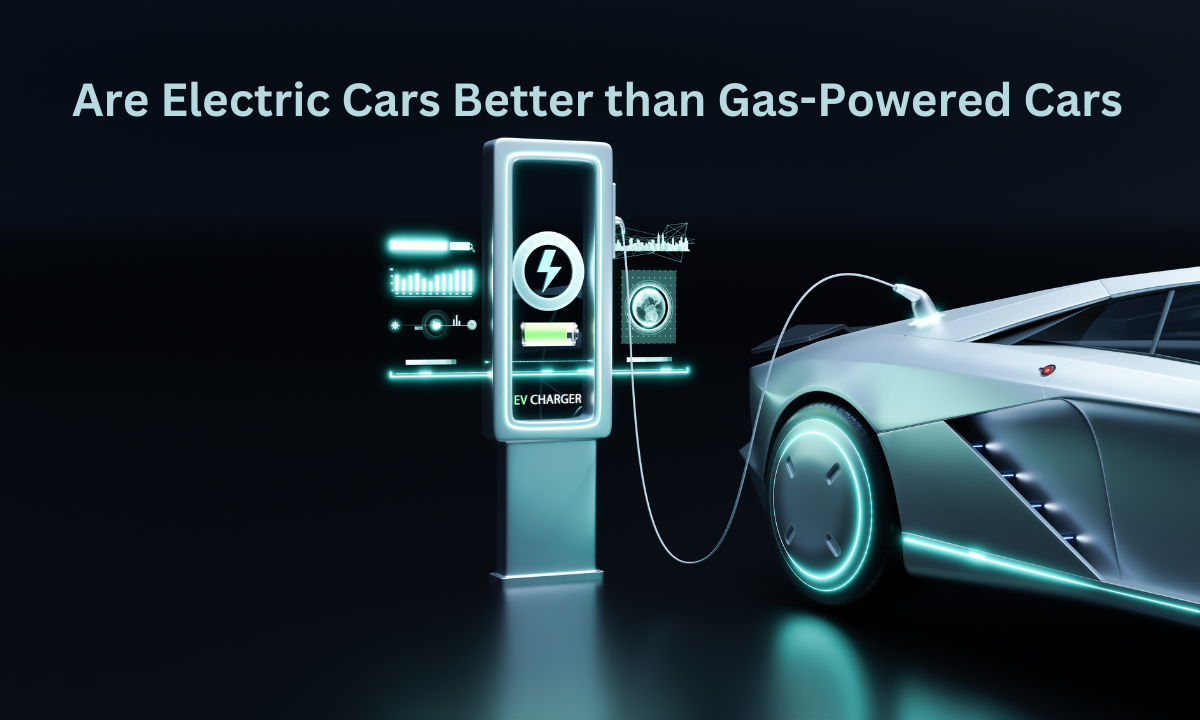Are Electric Cars Better than Gas-Powered Cars?
Introduction for Are Electric Cars Better than Gas-Powered Cars
Due to significant investments made by major manufacturers in this technology and growing consumer interest in switching from conventional gas-powered cars, electric vehicles (EVs) have been progressively gaining ground in recent years. Zero-emission vehicles (EVs) are becoming more and more popular as concerns about air pollution and climate change increase.
The question of whether electric vehicles are actually superior to their gas-powered counterparts is complicated, though, and there are many variables to take into account. We’ll examine the main areas where EVs and gas-powered automobiles differ in this post, weighing the advantages and disadvantages to assist you in making an informed choice.
Environmental Impact: EVs vs Gas Cars
Compared to gas-powered cars, electric vehicles have a smaller environmental impact, which is one of their biggest advantages. When an EV is operating, it doesn’t contribute to air pollution or greenhouse gas emissions because it produces zero direct emissions. Gas cars, on the other hand, create dangerous pollutants such carbon dioxide, nitrogen oxides, and particulate matter, which worsen air quality and contribute to climate change, especially in metropolitan areas.
It’s important to remember that EVs do not have a completely zero environmental impact. The environmental impact of producing electricity for electric vehicle charging remains contingent upon the energy sources utilized by the nearby power grid.
Overall emissions related to electric vehicles (EVs) are substantially lower than those of gas-powered vehicles if the electricity is produced using renewable resources such as solar, wind, or hydroelectric power. On the other hand, the carbon savings can be smaller if the energy is mostly derived from fossil fuel-based sources like coal or natural gas.
In addition, mining and processing elements like nickel, cobalt, and lithium during the production of EV batteries might have an adverse effect on the environment. It is anticipated that the overall environmental effect of battery manufacture and disposal will decline as recycling techniques improve and battery technology advances.
According to a study by the Union of Concerned Scientists, driving an electric car is better for the climate than driving a gas-powered car in all regions of the United States. The study found that EVs have lower greenhouse gas emissions than gas cars, even when accounting for the emissions from electricity generation.
To illustrate the emissions savings, let’s consider a few examples:

- Tesla Model 3: A Tesla Model 3 charged from the national electricity grid produces the equivalent of 88 grams of CO2 per mile, according to the EPA. In comparison, a gasoline-powered Toyota Camry produces around 320 grams of CO2 per mile.
- Nissan Leaf: The Nissan Leaf, another popular EV, produces around 92 grams of CO2 per mile when charged from the national grid. If charged from a renewable source like solar or wind, the emissions would be close to zero.
- Comparison to Gas Cars: According to the U.S. Department of Energy, the average gas-powered car emits around 404 grams of CO2 per mile, significantly more than the emissions associated with most EVs, even when accounting for the electricity generation emissions.
Furthermore, the environmental impact of gas cars extends beyond just greenhouse gas emissions. The extraction, refining, and transportation of gasoline also contribute to air and water pollution, as well as habitat destruction and other environmental consequences.
Battery Production and Recycling
The environmental impact of EV battery production is acknowledged, but it’s also critical to take the vehicle’s total lifecycle emissions into account. According to a research conducted by the International Council on Clean Transportation (ICCT), the greenhouse gas emissions linked to the manufacture of EV batteries are compensated for by the emissions savings realized when the vehicle is in use.
Enhancing the sustainability of battery production and recycling is another goal being pursued. A lot of automakers and battery producers are looking into closed-loop recycling technologies to recover and repurpose valuable elements from wasted batteries, as well as more environmentally friendly raw material procurement.
For example, Tesla has announced plans to build a Battery Recycling Facility at its Gigafactory in Nevada, which will recycle old batteries and recover valuable materials like nickel, cobalt, and lithium for reuse in new battery production.
Energy Efficiency and Running Costs
Electric cars are generally more energy-efficient than gas cars, as they convert a higher percentage of the energy stored in their batteries into motion. According to the U.S. Department of Energy, electric vehicles convert about 59%–62% of the electrical energy from the grid to power at the wheels, while conventional gasoline vehicles only convert about 17%–21% of the energy stored in gasoline to power at the wheels.
This higher efficiency translates into lower operating costs for EVs compared to gas cars. According to a study by the University of Michigan, the average cost of fueling an EV is around $600 per year, while the average cost for a gas-powered car is around $1,400 per year, assuming a gas price of $3.50 per gallon and an electricity rate of 12 cents per kilowatt-hour.
Additionally, EVs typically have lower maintenance costs than gas cars due to their fewer moving parts and the absence of components like spark plugs, timing belts, and engine oil that require regular replacement. However, it’s worth noting that the cost of replacing an EV’s battery pack can be significant and may offset some of the maintenance savings over the vehicle’s lifetime.
To illustrate the potential savings, let’s consider a few examples:
- Nissan Leaf vs. Toyota Corolla: According to a study by the Electric Power Research Institute (EPRI), the total cost of ownership over five years for a Nissan Leaf is around $24,600, compared to $28,200 for a Toyota Corolla. This includes the initial purchase price, fuel costs, and maintenance expenses.
- Tesla Model 3 vs. BMW 3 Series: A comparison by Consumer Reports found that over a five-year period, the Tesla Model 3 would cost around $15,000 less to operate than a comparable BMW 3 Series gasoline-powered sedan, primarily due to lower fuel and maintenance costs.
- Long-Term Savings: While the upfront cost of EVs is currently higher than gas cars, the lower operating costs can result in significant savings over the vehicle’s lifetime. According to a study by the Massachusetts Institute of Technology (MIT), the lifetime cost of ownership for an EV is around 20% lower than a comparable gas-powered vehicle.
It’s important to note that these cost comparisons can vary based on factors like the specific models being compared, local electricity and gasoline prices, and the driving habits of the owner. However, the overall trend indicates that EVs can offer substantial savings in terms of fuel and maintenance costs over the long run.
Performance and Driving Experience

When it comes to performance and driving experience, electric cars offer several advantages over their gas-powered counterparts:
- Instant Torque and Acceleration: Electric motors provide instant torque, resulting in rapid acceleration from a standstill. Many high-performance EVs can match or even outperform their gas-powered counterparts in terms of 0-60 mph acceleration times. For example, the Tesla Model S Plaid can accelerate from 0 to 60 mph in just 1.99 seconds, which is faster than most supercars like the Lamborghini Aventador and Ferrari 812 Superfast.
- Smooth and Quiet Ride: With fewer moving parts and no internal combustion engine, EVs offer a smoother and quieter driving experience compared to gas cars, which can be noisy and produce vibrations. The lack of engine noise in EVs can make for a more relaxing and enjoyable driving experience, especially in urban areas where noise pollution can be a significant issue.
- Driving Range: One of the main concerns with EVs has been the limited driving range compared to gas cars, leading to “range anxiety” for drivers. However, as battery technology continues to improve, the range of EVs has been increasing steadily. Many modern EVs now offer ranges of over 200 miles on a single charge, with some models like the Tesla Model S Long Range offering up to 405 miles of range, according to EPA estimates. This range is sufficient for most daily driving needs and longer road trips with proper planning for charging stops.
- High-Performance EVs: While early EVs were often associated with modest performance, many automakers are now introducing high-performance electric models that challenge their gas-powered counterparts. For example, the Tesla Model S Plaid, Porsche Taycan Turbo S, and Lucid Air Dream Edition can all achieve blistering acceleration and top speeds comparable to or exceeding many high-end sports cars. These high-performance EVs demonstrate that electric powertrains can not only be environmentally friendly but also exhilarating to drive, challenging the notion that EVs are inherently less exciting than gas-powered vehicles.
Are Electric Cars Really Better for Short Trips?
Although gas-powered cars tend to have a lesser overall environmental impact for short trips, some experts contend that electric vehicles (EVs) are more environmentally friendly than gas-powered vehicles. This is because, especially when driving short distances, the energy needed to produce an EV’s battery and the emissions related to the production of electricity may outweigh the emissions saved while driving the vehicle.
However, it’s important to take into account the EVs’ lifespan long carbon savings as well as the possibility of future cleaner electricity production. Furthermore, because they don’t emit any emissions from their tailpipes when in use, EVs have a substantial positive impact on the quality of air in metropolitan areas.
In most areas of the United States and Europe, EVs have lower greenhouse gas emissions than comparable gas cars even for short trips of about five miles, according to a study by the International Council on Clean Transportation (ICCT). This is assuming that the electricity grid has a moderate to low carbon intensity.
Moreover, EVs excel in stop-and-go traffic situations and urban driving because they can utilize regenerative braking to recover energy that gas-powered vehicles would otherwise lose as heat. In situations when driving occurs in cities, this may lead to increased energy efficiency and decreased emissions.
Upfront Cost and Incentives
The higher initial cost of EVs in comparison to gas-powered vehicles has been one of the main obstacles to their acceptance. EVs are still often more expensive than their gas-powered competitors, despite a steady decline in their purchase price.
To make up for EVs’ greater initial cost, a number of tax credits and incentives are offered. For the purchase of a new electric vehicle (EV), the federal government of the United States grants a tax credit of up to $7,500, and numerous state and local governments also provide extra incentives.
For example, in California, the Clean Vehicle Rebate Project (CVRP) offers rebates of up to $7,000 for the purchase or lease of eligible EVs, in addition to the federal tax credit. Other states like Colorado, Connecticut, and New York also offer incentives ranging from tax credits to exemptions from sales taxes and registration fees.
It’s also important to consider the potential long-term savings of owning an EV. While the initial cost may be higher, the lower fuel and maintenance costs can result in significant savings over the vehicle’s lifetime, potentially offsetting the higher upfront cost.
To illustrate the impact of incentives and long-term savings, let’s consider the following example:
- Tesla Model 3 Long Range: The base price of a Tesla Model 3 Long Range is around $49,990. After the $7,500 federal tax credit and a $2,000 state rebate (assuming a state like California), the net cost would be $40,490.
- Comparison to Gas Car: A comparable gas-powered luxury sedan like a BMW 3 Series might cost around $45,000 initially.
- Lifetime Cost Comparison: Over a 10-year period, assuming an average of 12,000 miles driven per year, the Tesla Model 3 could potentially save around $10,000 in fuel costs and maintenance compared to the BMW 3 Series, based on current gasoline and electricity prices.
In this example, the higher upfront cost of the Tesla Model 3 would be offset by the incentives and long-term savings, potentially making it a more cost-effective choice over the vehicle’s lifetime.
Charging Infrastructure: A Challenge for EV Adoption?
A major obstacle to the broad adoption of EVs is the infrastructure needed for charging them. Although many electric vehicle owners find home charging easy, range anxiety may be exacerbated by the fact that public charging stations are still few in some places.
Nonetheless, the infrastructure for charging is growing quickly, with more public charging stations being added every year. Furthermore, concerns about range anxiety are being lessened by improvements in battery technology and charging times.
According to the U.S. Department of Energy, there were over 47,000 public EV charging stations in the United States as of December 2022, with more being added regularly. Major automakers and charging network providers are also investing in expanding the charging infrastructure to support the growing demand for EVs.
For example, Tesla has been building out its Supercharger network, which now includes over 35,000 Superchargers worldwide, with the goal of enabling convenient long-distance travel for Tesla owners. Other charging networks like Electri City, EV go, and ChargePoint are also rapidly expanding their networks across the United States and other countries.
Apart from the growing quantity of charging stations, issues over range anxiety are also being mitigated by technological developments in charging. With the help of quick charging capabilities, many contemporary EVs can increase their range by hundreds of miles in as little as 15 to 30 minutes.
For example, while using a suitable high-speed charger, the Porsche Taycan can add about 200 miles of range in just 15 minutes because to its maximum charging power of 270 kW. With just 20 minutes of charging, the Lucid Air Dream Edition can add up to 300 miles of range at up to 300 kW of power.
While the charging infrastructure still has room for improvement, particularly in rural areas and along certain highway corridors, the rapid expansion and advancements in charging technology are making EVs more practical for long-distance travel and helping to address range anxiety concerns.
Sustainability and Future Outlook
As the world continues to grapple with the challenges of climate change and the need for more sustainable transportation solutions, the future outlook for electric vehicles is promising.
One key factor in the long-term sustainability of EVs is the integration of renewable energy sources for electricity generation. As more renewable energy sources like solar, wind, and hydroelectric power are added to the grid, the overall emissions associated with EV charging will decrease.
According to the International Energy Agency (IEA), the global share of electricity generated from renewable sources is expected to reach around 38% by 2030 and 60% by 2040, up from just 26% in 2019. This transition towards cleaner energy sources will significantly reduce the environmental impact of EVs throughout their lifecycle.
Additionally, advancements in battery technology are expected to lead to longer driving ranges, shorter charging times, and lower overall costs for EVs. Many automakers and technology companies are investing heavily in research and development of next-generation battery technologies, such as solid-state batteries and lithium-metal batteries.
For example, Quantum Scape, a solid-state battery startup, claims that its technology could enable EVs with ranges of up to 800 miles on a single charge, while also reducing the cost of battery packs by up to 50%. Similarly, companies like Tesla and Panasonic are working on developing more energy-dense and cost-effective lithium-metal batteries.
Perhaps most importantly, many major automakers have announced plans to phase out the production of gas-powered vehicles in favor of fully electric lineups. Companies like General Motors, Ford, and Volkswagen have set targets to go fully electric by the late 2030s or early 2040s.
For instance, General Motors has committed to becoming a fully electric automaker by 2035, with plans to invest $35 billion in electric and autonomous vehicle technology through 2025. Similarly, Volvo has announced that it will become an all-electric brand by 2030, phasing out the production of gas-powered vehicles entirely.
These commitments from major automakers, combined with the increasing demand for EVs from consumers and supportive government policies, suggest that the transition towards electric mobility is gaining momentum and will likely accelerate in the coming decades.
Conclusion
Many aspects need to be taken into account in the complex discussion about whether electric cars are preferable to gas-powered vehicles. Even though electric vehicles (EVs) have a lot to offer in terms of performance, energy efficiency, and environmental impact, gas cars still have some benefits, like less initial costs and the ease with which gas stations may be filled up.
The choice between an electric vehicle and a gas-powered vehicle will ultimately come down to your driving preferences, demands, and driving style. An EV can be a superior option if lowering emissions and your environmental effect are your main priorities, especially as battery and charging infrastructure advancements continue.
For the time being, though, a gas-powered vehicle can still be a more sensible choice if the upfront cost is your main worry or if you regularly go on lengthy road trips where charging might be difficult.
Future improvements in technology and the ongoing shift to renewable energy sources should make the benefits of electric vehicles even more apparent. Whatever position you take, it’s undeniable that the automobile sector is headed for a more electrified and sustainable future, and that shift will be greatly influenced by both consumers and automakers.
